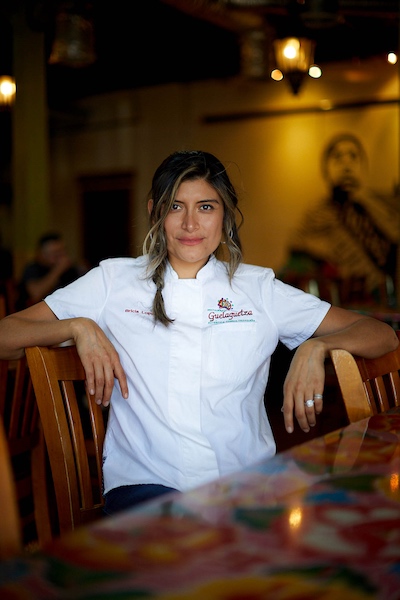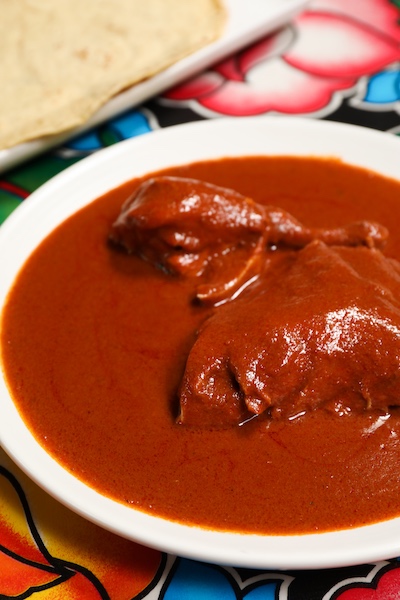Born in Oaxaca, Mexico, Bricia Lopez has called Los Angeles home since she was 10-years-old. In 1994, her father opened the family’s restaurant, Guelaguetza, a Zapotec word, which she explained signifies reciprocity. Today, she is the co-owner of Los Angeles’ Guelaguetza.
“If you live in Oaxaca, in one of these little pueblos, Guelaguetza is a tradition that people do to live in community. Almost a bartering system,” she explained at a recent live event for ICE students and alumni. When Oaxacan families celebrate or mourn, the community brings their guelaguetza, which can be anything of value, like a sack of beans or three chickens. “It is really a cultural transaction that keeps the local economy going and that’s really the spirit of guelaguetza — to live in community.”
 The restaurant Guelaguetza has been serving Los Angelenos for 27 years. “It’s a way for us to share our culture back, or our food, to the world,” Bricia said. At the center of Guelaguetza’s menu, and of Oaxacan cuisine, is mole. “Mole, of course, is at the heart of everything and what Oaxaca is and what it is known for." However, she explained, mole has been a bit misunderstood over the years.
The restaurant Guelaguetza has been serving Los Angelenos for 27 years. “It’s a way for us to share our culture back, or our food, to the world,” Bricia said. At the center of Guelaguetza’s menu, and of Oaxacan cuisine, is mole. “Mole, of course, is at the heart of everything and what Oaxaca is and what it is known for." However, she explained, mole has been a bit misunderstood over the years.
What is Mole?
“It is definitely not a chocolate sauce,” Bricia clarified. While chocolate is one of the ingredients — specifically Oaxacan chocolate — which features almonds and cinnamon, it is not the main component. “We sweeten [mole] and season it with chocolate and salt, just how you would season anything." Balancing flavors is the goal and the regional style of chocolate is used. “That’s what mole is, achieving this beautiful umami flavor, this perfect balance of sweet and savory together."
The second misconception Bricia dispelled is that mole takes a long time to prepare. She explained that travelers who may have observed women in villages making mole for days, have likely witnessed them preparing mole for big feasts. “That is usually because any celebration that you have, you invite your closest 400 friends to celebrate with you,” she said, adding that the work that goes into preparing mole should not be undervalued. “It doesn’t take days to make, but it does require a high level of love and balance.”
Here, Bricia describes the key components that comprise mole.
Mole Spice
 “The spice is almost like a trail mix combination that has been stone-ground into a paste,” she said. “If you want to achieve the perfect mole, you definitely need a stone mill.” Guelaguetza’s includes sesame seeds, almonds and toasted peanuts. “This is the recipe that my family has been doing for generations. We don’t want to change it, we want to preserve it."
“The spice is almost like a trail mix combination that has been stone-ground into a paste,” she said. “If you want to achieve the perfect mole, you definitely need a stone mill.” Guelaguetza’s includes sesame seeds, almonds and toasted peanuts. “This is the recipe that my family has been doing for generations. We don’t want to change it, we want to preserve it."
In addition to the nuts, there are aromatics — cinnamon, thyme, oregano, garlic and onion — combined with raisins, which are all heated so that they fully come alive. “You can fry each one individually, you can roast, it’s really up to you,” she said. Also in the mixture: a plantain roasted whole, which is used to thicken the paste. She emphasized that none of the ingredients should remain raw. Heating the ingredients is where the flavor comes from.
Chiles Are Critical
Working with chiles, which are the key to the varieties of mole, requires engaging all your senses. “You need to smell to be sure [the chile] doesn’t burn, you need to see, so it is blistered but not all the way. That sophistication only comes with tradition which comes with making it over and over and over again,” she said. Chiles go through a process from rehydrated to roasted to seeded and chopped.
Roasting is important for the flavor profile of the mole. “We love smoke in Oaxaca,” Chef Bricia said. “Everything is open-fire cooking and everything is about roasting, roasting, roasting. For me, anything that hasn’t been roasted before being added somewhere, it just lacks that depth of flavor.”
Once you have the chiles prepared, you blend them with some of the soaking liquid from their rehydration. The result is a silky, superfine almost puree. “If making at home, you could never get something so silky through a Vitamix, you have to pass it through a stone ground mill,” Bricia advised. In Oaxaca, each pueblo has its own mill. “You would take your ingredients that you roasted at home, walk to the mill, give them your stuff, and you walk home with your chile mixture and your spice mixture.”
The chile and spice mixtures are then combined with a liquid tomato and broth, which historically is chicken. It is then seasoned with salt and Oaxacan chocolate. “As Oaxacan chocolate is made with almonds and cinnamon, you feed on and enhance those flavors of the mole,” Bricia said. The mole is then thickened with a Oaxacan egg yolk bread, called pan de yema, which Guelaguetza bakes from scratch. After about two hours of boiling down, you have your mole. “I think it is superb in every single way,” Bricia said. “It is just the epitome of what Mexican cooking is. It’s really what Oaxaca is.”
Make regional specialties from Mexico in ICE's Culinary Arts program.




